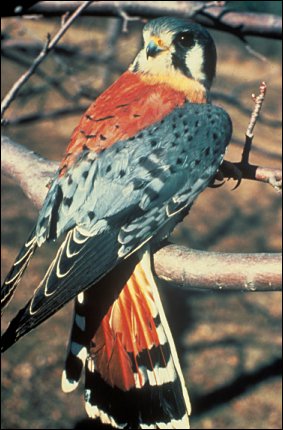Landscape, Animals, and Plants Home

![]()
American Kestrel (Falco sparverius)
 Name
Derivation:
Name
Derivation:
American: referring to its New World
distribution.
Kestrel: probably from the Old French
kerserl or caserel which is derived from Latin
crepicella meanig to rattle or creak, referring to its
call.
Falco: from Latin falc meaning
"falcon".
sparverius: Latin
meaning "relating to a sparrow", alluding to its size and prey.
Other names:
American Sparrow Hawk, Rusty-crowned Falcon, Windhover; Spanish – Cernícalo chitero, gavilancito enano.
Systematics:
Class: Aves; Order: Falconiformes; Family: Falconidae.
Key Identification Characters:
Males with two mustache marks on cheeks; crown bluish with central rufous spot; reddish tail with only one dark band near tip; upper wing coverts bluish; female similar to male but with rufous brown crown, tail rufous and banded, upper wing coverts rufous brown with black banding. Length, 9"; wingspan, 22".
Distribution:
North America southward to Tierra del Fuego in South
America.
El Paso Region: common migrant and winter resident, fairly
common summer nester.
Food:
Mainly insects (grasshoppers, beetles); small mammals (voles, bats, cotton rats); birds (from sparrow to Mourning Dove size); small lizards, snakes, frogs.
Breeding:
Number of eggs/clutch: range 2–6, normally 4-6; egg: creamy to yellowish-buff color sprinkled, spotted, or blotched with shades of reddish brown; 1.35" x 1.10"; nesting: cavity nester in trees (or nest boxes) from 2' to 72' above the ground.
Photo Credit: Menke, Dave, U.S. Fish and Wildife Service
Contributor: Scott M. Cutler, Curator of Collections and Exhibits; Curator of Ornithology